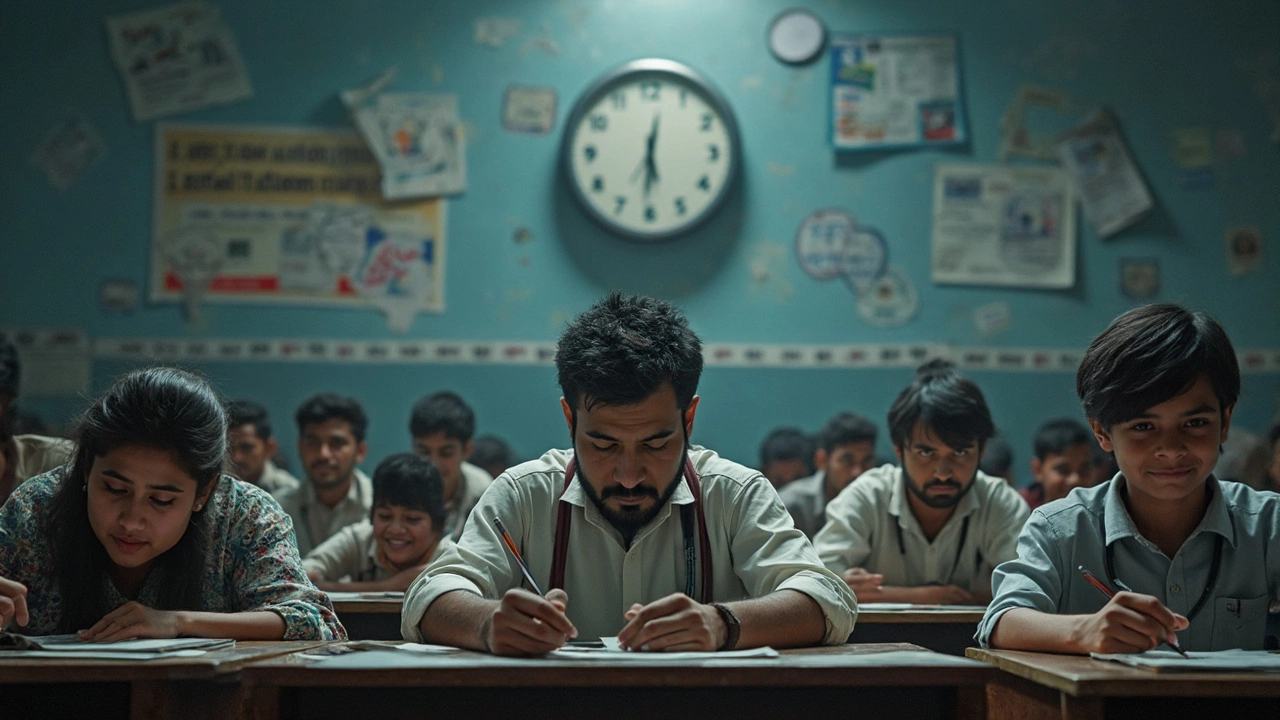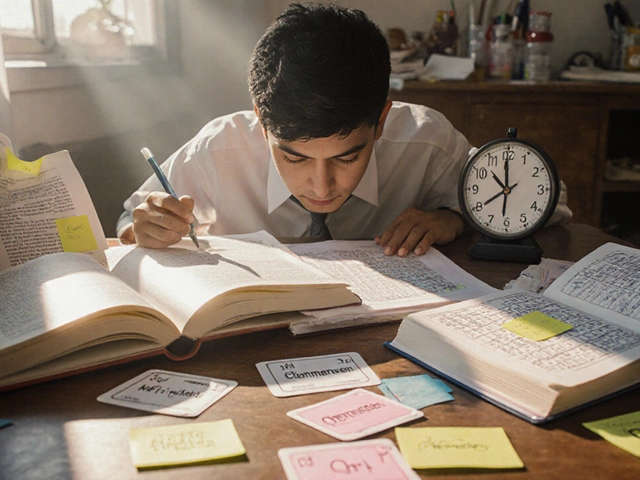Most people think medical school is the finish line, but the real gauntlet comes after: the license exam. It isn’t just about what you memorized or crammed the night before—these tests are monsters, built to trip up even the best students. Imagine years of study boiling down to one or two marathon days. Pressure? That’s putting it lightly.
Every country has its version, but some of these exams have a reputation that keeps doctors up at night. We’re not just talking about hard questions, but mile-long formats, tricky scenarios, and a grading system that makes the Olympics scoreboard look forgiving. Want to know which one is the scariest of them all? Or how people actually beat the odds? Let’s break down what makes these exams so tough, what you’re really up against, and how you can actually stand a chance if one’s in your future.
- Medical License Exams Explained
- What Makes an Exam 'The Hardest'?
- USMLE: The Gold Standard of Toughness
- PLAB, AMC, and Other Challengers
- Real Stories from Test Takers
- Tips to Survive (and Maybe Ace) the Hardest Exams
Medical License Exams Explained
If you want to actually see patients or write prescriptions, passing a medical license exam isn’t optional—it’s your only way in. These tests aren’t there to torture doctors (though it can feel like it). They're designed to make sure the people treating you actually know what they're doing. Sounds simple, but the details can get wild.
Each country sets their own rules. The USMLE (United States Medical Licensing Examination) is the main gateway for doctors in the USA. The UK asks aspiring doctors from abroad to clear the PLAB (Professional and Linguistic Assessments Board) test. Australia has the AMC (Australian Medical Council) exam, and Canada uses the MCCQE (Medical Council of Canada Qualifying Examination). Every one of these has its own format, content, and nerve-wracking quirks.
Most of these exams have a mix of written multiple-choice questions, case studies, and sometimes a practical part where you deal with actors pretending to be patients (yes, it gets awkward). The point? To check you’re not just good at theory but can also handle real humans with real problems.
Here’s a quick breakdown so you see just how much these exams can differ:
| Exam | Main region | Typical duration | Key Features |
|---|---|---|---|
| USMLE | USA | Up to 8 hours per step | Multiple steps, intense clinical scenarios |
| PLAB | UK | 2 days | Written test + practical stations |
| AMC | Australia | Varies | Written + clinical exams |
| MCCQE | Canada | 2 days | Written + simulated cases |
It’s a lot, and no two tests are identical. That’s why medical students swap horror stories and strategies online, especially about the hardest medical exam in their country. No matter where you’re headed, getting licensed isn’t something you can just wing because there’s a real system holding up the bar.
What Makes an Exam 'The Hardest'?
So what actually earns a medical test the scary title of being the hardest medical exam? It’s not just about the number of questions crammed into a sitting. There’s a real mix of stuff that pushes these exams way beyond the usual classroom quizzes.
- Volume of Content: We’re talking about years of medical knowledge condensed into a few hours or days. Some exams, like the USMLE, cover everything: from biochemistry you learned in year one to clinical work you did last month.
- Style of Questions: Forget multiple choice like you know it. Many of these exams use trick questions, case studies, and “best answer” formats. For example, both the USMLE and PLAB often have questions with more than one technically correct answer—but you need to pick the most ‘right’ one.
- Time Pressure: Some licensing tests give you only a minute per question, and you can’t go back. Talk about stress.
- Pass Rates: Tests with lower pass rates usually win the crown for toughness. For instance, the USMLE Step 1 had a pass rate of about 82% for first-time international medical graduates in 2023. That means nearly 1 in 5 hardworking candidates just don’t make it.
- Practical Components: Exams like the USMLE Step 2 CS (when it was still running), PLAB Part 2, or Australia’s AMC clinical exam also pile on real-life patient simulations. You’re not just regurgitating facts, you’re being judged on your every move.
- Exam Length: Hours and hours of testing, sometimes over multiple days. The USMLE Step 2 CK, for example, takes a whopping 9 hours!
Let’s put some of this data side by side so you can see how brutal it really gets:
| Exam | Questions | Duration | Pass Rate (Latest) |
|---|---|---|---|
| USMLE Step 1 | 280 | 8 hours | 82% (IMGs, 2023) |
| PLAB Part 1 | 180 | 3 hours | Approximately 72% |
| AMC MCQ | 150 | 3.5 hours | ~60-65% |
What really makes the hardest medical license exam isn’t just one single thing. It’s this cocktail combination—tough questions, huge topics, relentless time limits, and the real risk of going back to the books if you fail. Not to mention the pressure of your whole career riding on just one score.
USMLE: The Gold Standard of Toughness
When people talk about the hardest medical exam, the USMLE almost always comes up. The United States Medical Licensing Examination is split into three steps, and each one is its own hurdle. Step 1 covers basic science, and for years, it was the monster that med students dreaded the most. Scores from Step 1 could make or break your dreams of landing a top specialty, which made the pressure sky-high. In 2022, Step 1 shifted to pass/fail, but don’t think that made the test ‘easy.’ The content still runs deep and wide, and failing means repeating a full year in some cases.
Step 2 pushes you on clinical knowledge and patient care, grilling you with endless vignettes that aren’t just about facts—they want critical thinking, quick choices, and safe decisions. For years, there was also Step 2 CS (clinical skills), but it was dropped during the pandemic and hasn’t come back. Step 3 is no walk in the park either, diving into patient management over two long days. The format demands you work through real-case scenarios on a computer, making snap decisions with limited time.
This isn’t just a bunch of hard questions thrown at you. The USMLE tests how you think, how you handle pressure, and how quickly you can spot what matters in messy, confusing situations. Average prep time? Most people spend 3 to 6 months, balancing practice questions, review books, and mock exams. Here’s what the USMLE looks like in numbers:
| Step | Format | Length | Pass Rate (2023) |
|---|---|---|---|
| Step 1 | Multiple choice, 7 blocks | 8 hours | 93% (US grads) |
| Step 2 CK | Multiple choice, 8 blocks | 9 hours | 97% (US grads) |
| Step 3 | Multiple choice + simulations | 2 days (7+9 hours) | 97% (US grads) |
The stats suggest most people pass, but don’t let it fool you. These are super-motivated, top-tier students, and the emotional toll is real. One slip can mean a costly delay—retaking the USMLE is expensive, and there’s a tight limit on tries. People talk about the ‘USMLE grind’ for a reason: it eats up your time, social life, and sometimes your confidence. Planning and consistent practice are the only way through it. If there’s a true ‘gold standard’ of medical licensing exams, USMLE wears that crown without question.

PLAB, AMC, and Other Challengers
If you’re aiming to practice medicine outside the US, you’ll probably run into other famous (or infamous) medical license exams like the PLAB for the UK and the AMC for Australia. These are legit tough, but each one is its own brand of difficult.
The PLAB—Professional and Linguistic Assessments Board—test is what international grads need to work as doctors in the UK. It’s split into two parts. Part 1 is all about theory—180 single best answer questions you have to knock out in three hours. It covers stuff like clinical medicine, surgery, and ethics, so no skipping the boring bits. Part 2 is an OSCE, meaning you rotate through real-life scenarios with actors pretending to be patients. You’re rated on everything from diagnosing to bedside manner, so it’s not just about book smarts. About 65-75% of candidates pass on their first try, which is way lower than most high school tests, but higher than the USMLE.
Australia’s AMC (Australian Medical Council) exams go for a similar two-step process. The AMC CAT MCQ (catchy name, right?) is 150 multiple-choice questions, and you have just over 3 hours to finish. If you clear that, there’s a clinical exam—16 stations covering every corner of medicine and surgery, each eight minutes long. Less than 40% passed the AMC clinical exam back in 2023, which puts it firmly in the ‘no joke’ category.
The hardest medical exam debates usually come down to the USMLE, but these other tests aren't just walk-throughs. Canada’s MCCQE and India’s NEET-PG have their own headaches: huge syllabi, strict time limits, and sky-high cutoffs. If you really like data, check this out:
| Exam | Country | Pass Rate (Recent) | Main Format |
|---|---|---|---|
| PLAB Part 1 | UK | ~72% | MCQ |
| PLAB Part 2 | UK | ~66% | OSCE/Clinical |
| AMC Clinical | Australia | ~38% | OSCE/Clinical |
| MCCQE Part 1 | Canada | ~95% | MCQ/SJT |
| NEET-PG | India | ~14% | MCQ |
So, which exam is "hardest" depends on what makes you sweat: tricky cases, massive question banks, split-second decisions, or how few actually pass. One thing is clear: you definitely can’t just wing it with any of these.
Real Stories from Test Takers
There’s nothing quite like hearing straight from the people who actually survived the world’s toughest medical licensing exams. Their stories are packed with no-frills truth and super practical tips you won’t find in official study guides.
Let’s start with the USMLE. A lot of American med students say Step 1 is a nightmare. One student, Raj, shared on Reddit that he spent nearly 10 hours a day for three months reviewing random biochemistry pathways. He joked that he ‘dreamed in acronyms’ for weeks. The kicker? Raj scored a 240—a great number, but even then, he said he wasn’t sure what half the questions were really asking. The constant fear: missing the curve, since scoring percentiles change every year.
Others talk about the fatigue. Step 2 CK comes as a second round—nine hours straight with only short breaks. Samantha, a recent med school grad, described it as ‘less about what she knew and more about whether her brain would stop working after hour six.’ She said her practice exams felt nothing like the real test, and she walked out seriously doubting if she’d passed.
Doctors who try the PLAB in the UK face a different beast. There’s a practical part where actors pretend to be patients, and you’re judged not just on your answers but your bedside manner. Ahmed, a physician from Egypt, shared that after all his book studying, he nearly panicked when asked to break bad news to a patient-actor and was docked points for failing to show enough empathy. ‘You have to act like a real doctor, not a robot,’ he said.
And it’s not only about knowledge or language skills. Some candidates for the Australian Medical Council (AMC) exam say the most stressful part is the uncertainty—no official pass rate is posted, but unofficially it hovers around 50-60%. Seeing others fail after years of hard work seriously messes with your confidence.
| Exam | Typical Duration | Known Pass Rate |
|---|---|---|
| USMLE Step 1 | 8 hours | ~90% (US med grads) |
| USMLE Step 2 CK | 9 hours | ~96% (US med grads) |
| PLAB 1 & 2 | 2 hours (PLAB 1), 8 stations (PLAB 2) | ~70% |
| AMC | 3.5 hours (MCQ), 2 days (Clinical) | 50-60% |
The biggest eye-opener from these stories? Even the smartest, most prepared people struggle. Everyone deals with anxiety, time pressure, and curveball questions. That’s why real-life hacks—like studying in timed blocks, practicing empathy for practicals, or connecting with peers who’ve taken the same test—often matter as much as the content itself.
Tips to Survive (and Maybe Ace) the Hardest Exams
If you’re staring at the hardest medical exam on your horizon, here’s the lowdown: strategy matters just as much as raw knowledge. People who clear the toughest tests like the USMLE or PLAB aren’t superhuman. They’re just really smart about how they prep.
- Know the Format Inside Out: The USMLE Step 1, for example, is an all-day slog with blocks of multiple-choice questions. The PLAB tests clinical scenarios over two days. Get a feel for the pace and question types long before exam day.
- Practice, Don’t Just Read: Research shows practicing with question banks is way more effective than rereading textbooks. For the USMLE, students who used over 2,000 practice questions scored on average 10 points higher.
- Schedule Mock Exams: Sitting a full-length, timed mock exam shows you exactly where your stamina and knowledge break down. Don’t wait until test day to find out you freeze during clinical vignettes.
- Active Recall and Spaced Repetition: Apps like Anki and Quizlet are popular because they force your brain to work, not just skim. Setting reminders to review material over weeks locks info in better.
- Focus on High-Yield Topics: Every tough exam has some predictable topics that show up again and again. For USMLE Step 1, stuff like biochemistry, pathology, and pharmacology dominate the test.
- Don’t Ignore Test Strategy: Even top scorers get stumped. Learn to narrow down choices, guess smart, and don’t burn time panicking over one question.
If you’re juggling work or internship hours, you’re in good company. A 2022 survey revealed 74% of USMLE takers were also working hospital shifts while studying. Time management isn’t just advice—it’s survival.
| Popular Prep Resource | Used by (%) Top Scorers |
|---|---|
| UWorld (Question Bank) | 89% |
| First Aid for the USMLE | 75% |
| Anki (Flashcards) | 68% |
One last thing—don’t go it alone. Join a study group, hit forums, or connect with people tackling the same competitive exams. Sometimes, just hearing how others tripped up (and bounced back) is the most reassuring thing you’ll get during this wild ride.








